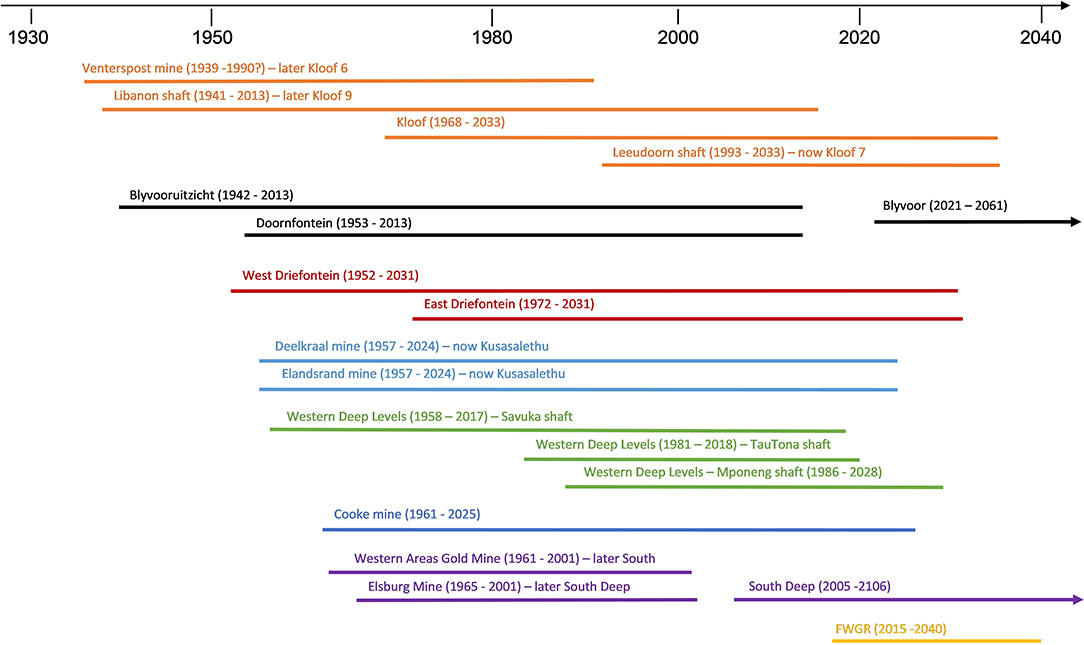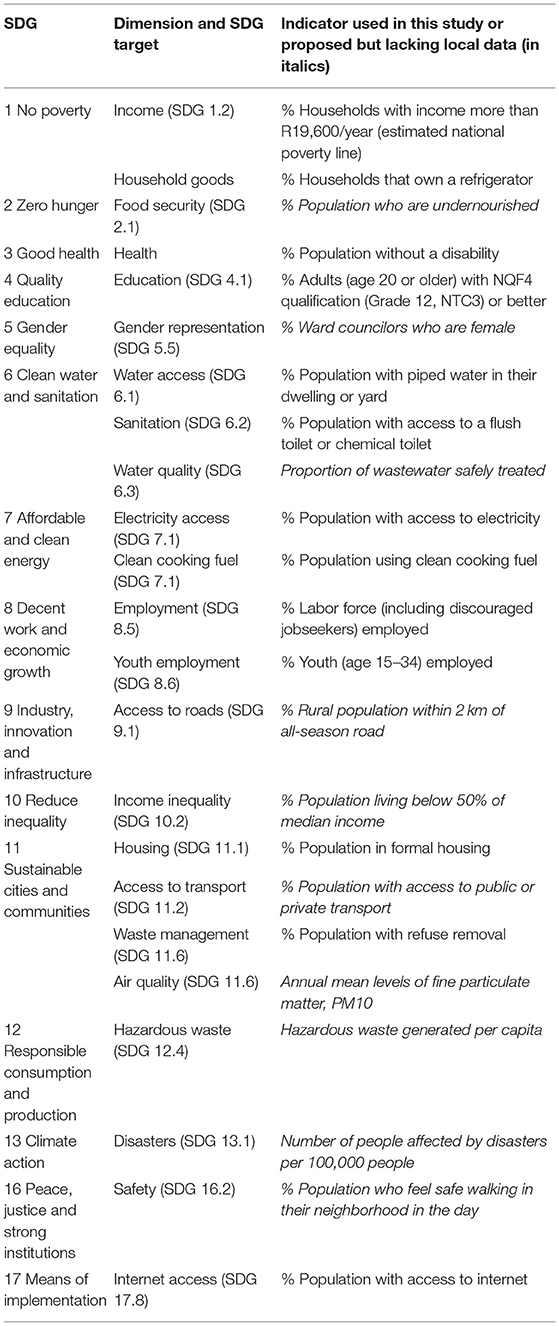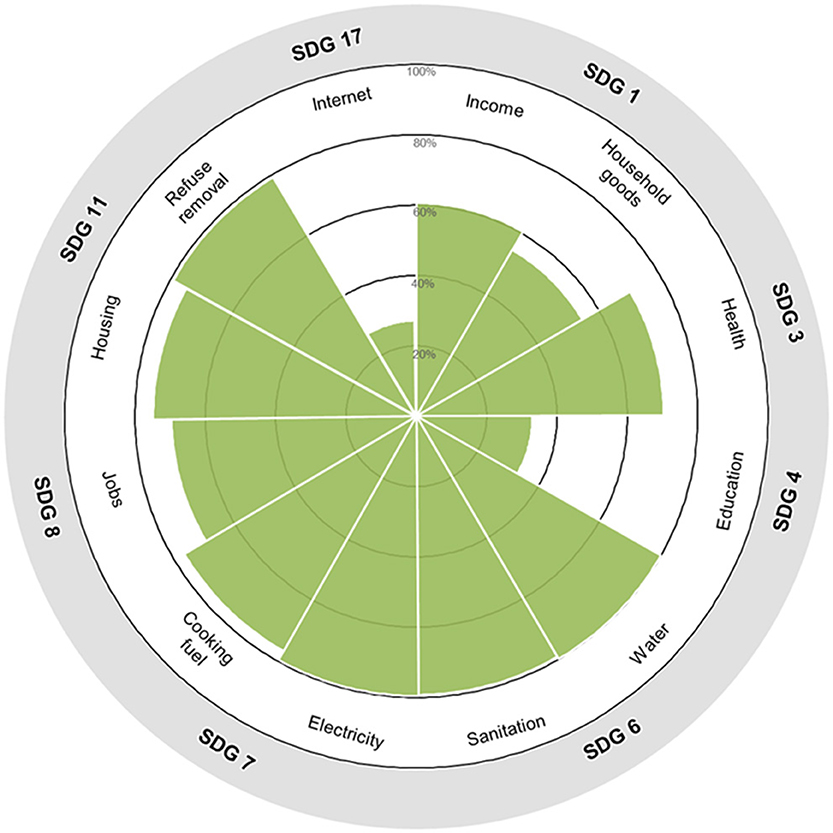- 1Minerals to Metals Initiative, Department of Chemical Engineering, University of Cape Town, Cape Town, South Africa
- 2Future Water Institute, Faculty of Engineering and the Built Environment, University of Cape Town, Cape Town, South Africa
There is a significant role for the mining and minerals industry to play in achieving the Sustainable Development Goals (SDGs) at a global level, through supplying the raw materials needed for technological progress, human development and cleaner economic growth, and at a local level, through socio-economic development and support, environmental protection, and good governance. While mining companies support the SDGs at the corporate level, there is a lack of evidence to show whether they are being implemented at the mine site level. There is also a lack of clarity on who the mine host communities are and what happens to the SDGs commitments after mine closure. The aim of this study was to identify all the host communities in the West Wits goldfield in South Africa and measure a comprehensive set of local SDG indicators, to explore the local variations that are hidden at national and municipal level, and the implications for communities achieving the SDGs in the context of mine closure. The West Wits is home to over 300,000 people living in 47 diverse communities—towns, mine villages, townships, informal settlements, industrial areas and rural areas. While 23 local SDG indicators were selected, only 13 indicators across 8 SDGs could be measured using census data. The findings show significant inequality between communities and deprivation in many communities, particularly the informal settlements. There are low levels of education, internet access and employment across the communities, indicating high vulnerability to mine closure. Without major intervention the SDGs will not be met by 2030 and thousands of people in these communities will be left behind. This is even more concerning given the majority of mines are expected to close in the next 10–20 years and the local economy in the West Wits is largely reliant on mining. Achieving the SDGs will require collaboration between multiple mining companies, local government authorities, civil society and communities, and significant urgent interventions on education and skills development, internet access and employment creation beyond the mining industry.
Introduction
The global “Agenda 2030 for Sustainable Development” and its Sustainable Development Goals (SDGs) were developed through a three-year international process that engaged stakeholders from national governments, multilateral organizations, academia, civil society, and the private sector. They were adopted by the 193 countries of the United Nations (UN) General Assembly in September 2015 and represent an unprecedented global commitment to poverty alleviation, environmental protection, equality, peace and justice (UN General Assembly, 2015). The 17 SDGs are wide-ranging and address environmental, social and economic challenges through 169 targets and 251 global indicators (UN Statistical Commission, 2020). As the SDGs are global goals, work is ongoing around the world to adapt them to the national and local levels (local2030.org), which involves adding indicators and refining existing indicators. Whilst overall responsibility lies with national governments, the SDGs cannot be achieved without a collective, collaborative and coordinated efforts by public and private parties (Yakovleva et al., 2017).
There is a significant role for the mining and minerals industry to play in achieving the SDGs by providing raw materials for technological progress, economic growth and human development (Vidal et al., 2013; Elshkaki et al., 2016), by paying royalties and taxes which support national government efforts, by providing employment, infrastructure and corporate social investment, and by operating sustainably and avoiding negative social, environmental and governance impacts (CCSI et al., 2016; ICMM, 2018; Mancini and Sala, 2018; Sturman et al., 2018; Fraser, 2019). Over the past two decades, demand for the major metals has increased (Luckeneder et al., 2021) and it is expected to continue to grow to 2050, particularly for the critical metals necessary for the clean energy transition (Elshkaki et al., 2018; Watari et al., 2020; Bainton et al., 2021). The Yale Major Metals scenarios show that the greatest demand will occur if the world follows an equitable track—ensuring that developing countries achieve economic growth and a better standard of living (Elshkaki et al., 2018). Thus, achieving the SDGs will require a significant increase in mining for numerous metals. The new orebodies are likely to be deeper, lower grade and more remote or on more sensitive land, require greater energy and water, and produce more waste (Bainton et al., 2021). Thus, they could also hinder the achievement of the SDGs and environmental, social and governance (ESG) issues will be of great importance when designing, planning and operating these mines (Lèbre et al., 2020).
Mining companies often spend significant resources at the local level where their mines sites operate for long periods of time, they can therefore make a big contribution to local development. There are many examples of mining companies creating shared value for themselves and their host communities, contributing to achieving the SDGs (Brink and Pienaar, 2007; CCSI et al., 2016; Yakovleva et al., 2017; Broadhurst, 2019; Moomen et al., 2019; Kumi et al., 2020; World Gold Council, 2020). Since the inception of the Mining and Metals for Sustainable Development initiative in the late 1990s, there has been a proliferation of sustainability initiatives in the mining industry (Sturman et al., 2018), and the SDGs provide an opportunity for mining companies to align their strategy, incentive mechanisms and interventions to national and sub-national priorities (Maennling and Correa, 2020). The SDG indicators are useful for assessing baseline needs of mining communities, tracking performance over time, measuring the impact of interventions by mining companies and the effectiveness of government policy interventions (Maennling et al., 2019; Cole and Broadhurst, 2021). All the major mining companies have committed to supporting the SDGs, and although companies are increasingly aligning their sustainability reporting with the SDGs, they often highlight the positive contributions while omitting any negative impacts that would hinder progress toward the SDGs (Responsible Mining Foundation, 2020).
South Africa has been a leader in reporting on the MDGs and SDGs, despite facing significant challenges to “leave no-one behind”, being one of the most unequal countries in the world (StatsSA, 2019a). At the local level there is huge variation in levels of well-being, access to services and public goods (Cole et al., 2017, 2018). Mining has played a fundamental role in South Africa's economic development, starting with the diamond rush to the Kimberley area in 1870 and the gold rush to the Witwatersrand in 1886, which led to massive immigration, urbanization, capital investment and labor migration (Bundy and Cobbing, 2019). Today South Africa is a leading global producer of platinum group metals, chromium, manganese, vanadium, gold, coal, iron ore and several other metals and minerals (Yager, 2021). Over 90 cities, towns, and villages in South Africa host 198 large-scale mines, situated within a quarter of the country's local municipalities (Cole and Broadhurst, 2021).
Due to the mining industry's role in the historic racial inequality and the development of the migratory labor system, seen as a key component of the oppressive apartheid system (IRR, 2014), mining companies in South Africa are required to share the benefits of mining with mine employees and mining communities (DMR, 2010). The Mineral and Petroleum Resources Development Act (MPRDA) of 2002 (Republic of South Africa, 2002) is effected through the Mining Charter (DMR, 2018), the Guideline for Implementation of a Social and Labor Plan (DMR, 2010) and Housing and Living Conditions Standard (DMR, 2019). If these are properly implemented, they will contribute to achieving several SDG targets, particularly adequate housing (SDG 11.1), access to electricity (SDG 7.1), piped water (SDG 6.1), sanitation (SDG 6.2), roads (SDG 9.1), healthcare services (SDG 3.8) and sufficient, balanced nutrition (SDG 2.1). Mining itself contributes to decent work (SDG 8) and reducing poverty (SDG 1) while mining companies' local economic development projects and Corporate Social Investment programmes generally focus on health (SDG 3), education (SDG 4), skills development and job creation (SDG 8), and fostering local enterprise and economic diversification (SDG 8) (Hamann, 2004).
The aim of this study was to identify all the host communities in the West Wits goldfield in South Africa and measure a comprehensive set of relevant SDG indicators, to explore the local variations in well-being that are hidden at national and municipal level, and the implications for communities achieving the SDGs in the context of mine closure. Section The West Wits Goldfield describes the history of mining and communities in the West Wits goldfield in South Africa, situated on the Witwatersrand Basin, which is facing mine closure. Section Methodology describes the methods used for identifying the 47 communities that surround the mines and are home to over 300,000 people who live in towns, mine villages, townships, informal settlements, industrial areas and rural areas. It describes the identification of 23 relevant SDG indicators and the selection of 13 indicators from SDG 1, SDG 3, SDG 4, SDG 6, SDG 7, SDG 8, SDG 11 and SDG 17 that could be measured using census data. Section Results presents the results of the data collection and analysis which are described, summarized and visualized in radar plots or “barometers for well-being”. Section Discussion discusses the results considering local SDG indicators and data, the challenges in defining mining host communities, and the risks and opportunities related to mine closure.
The West Wits Goldfield
Mining History of the West Wits
South African gold mining is located in the Witwatersrand Basin, the world's largest goldfield which stretches in an arc over 400 km and has seven discrete gold fields, 98 gold-bearing reefs and has been mined at over 146 mines since 1886 (Tucker et al., 2016). These mines have produced more than 52,000 tons of gold, more than a third of all gold globally (Tucker et al., 2016). Gold mining was initially focused on the Central Rand and West Rand, and later the East Rand, and rapid population growth led to the establishment of the towns of Johannesburg, Krugersdorp, Randfontein and Roodepoort in the 1880s (Winde and Stoch, 2010). The huge demand for labor led the gold mining companies to form the Native Recruiting Corporation in 1912 that recruited black workers from across southern Africa (Bezuidenhout and Buhlungu, 2010). In the 1930s, mining extended further south-west to Klerksdorp and the West Wits (also called the Far West Rand), southwest of Randfontein (see Figure 1). The West Wits goldfield hosts the deepest mines in the world reaching depths of 4 km (Tucker et al., 2016) and at their peak, were the richest gold mines in the world (van Eeden, 1997; Winde and Stoch, 2010).
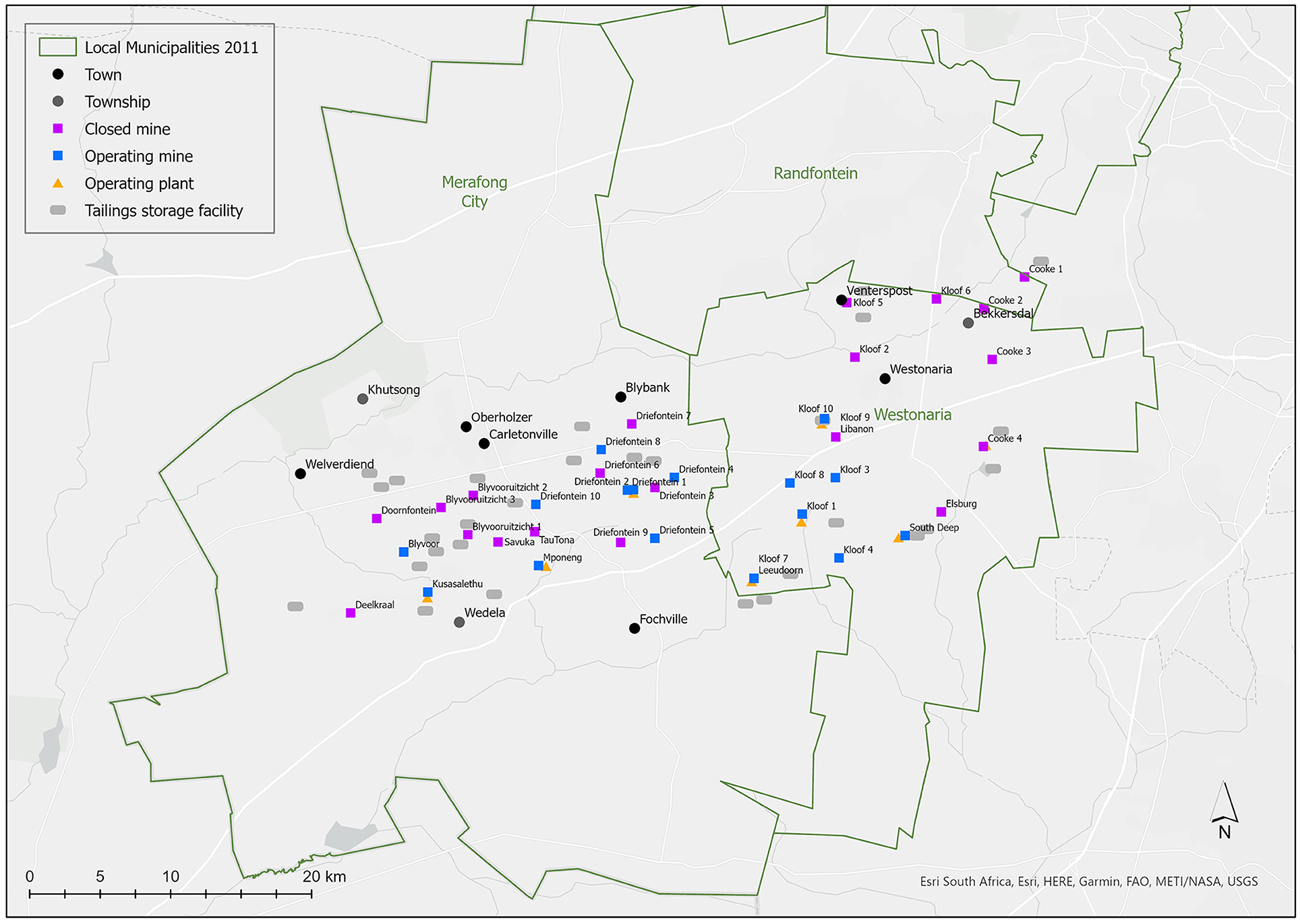
Figure 1. Map of the communities, mines, operational processing plants and tailings storage facilities in the West Wits goldfield.
The first geological survey of the West Wits was done at Doornfontein in 1932 and proved the continuity of the central Witwatersrand Main Reef and the presence of a new high-grade reef, dubbed the Carbon Leader. Figure 2 shows a timeline of mining operations on the West Wits, based on a literature review of mining company reports and academic papers. Shaft sinking began at Venterspost shaft in 1934 and Libanon shafts in 1936 and 1939 (now part of Kloof Gold Mines) and continued for decades in the area (Gold Fields, 2009a). Rand Mines registered the Blyvooruitzicht Gold Mining Company in June 1937, began production in 1942 and soon became the most profitable mine in the world with very high in situ grades (Blyvoor Gold, 2022). The Blyvooruitzicht uranium pilot plant came into operation in 1949 (Ford, 1993). In 1945 the West Driefontein Mining Company sunk two shafts and started milling in 1952 (Gold Fields, 2009a) while during the 1950s Doornfontein 1 Shaft was developed. In 1957 Anglo American opened three new mines—Deelkraal and Elandsrand (now called Kusasalethu and owned by Harmony) and Western Deep Levels (later called Savuka and owned by AngloGold Ashanti). Two more Blyvooruitzicht shafts were sunk in 1960, and in 1961 Western Areas Gold Mine (later South Deep) began production and Cooke Gold Mine was established. Elsburg Gold Mine (now South Deep) opened in 1965, Kloof Gold Mine in 1968 (Gold Fields, 2009b) and East Driefontein in 1972. Further shafts were sunk and gold processing plants were established in the area in the 1970s and 1980s, including TauTona in 1981. Leeudoorn shaft (Kloof) and the Mponeng mine both opened in 1993. South Deep completed a new shaft and commissioned a new gold plant in 2002 and converted from conventional to mechanized mining in 2009, the first to do so in the area. All the gold doré from these mines is sent to the Rand Refinery in Germiston, which was established in 1920 by the Chamber of Mines South Africa (Rand Refinery, 2020).
To support the rapidly developing mining industry, new (open1) towns were proclaimed—West Wits in 1937, Venterspost in 1937, Westonaria in 1938, Oberholzer in 1939, Bank in 1940, Welverdiend in 1942, Blybank in 1947 and Carletonville in 1948—though Bank did not survive due to the problem of sinkholes (van Eeden, 1997). The first township2, Bekkersdal, was established in 1945 to house black African workers followed by Khutsong in 1958 and Wedela in 1978. Bekkersdal expanded significantly in the 1990s through informal settlements, which now house two thirds of residents (Liefferink et al., 2017). From the 1950s, mining companies built mine villages adjacent to the new mines to house white mine workers in mine houses and black workers in compounds or hostels. Unlike the towns, these villages were for mine employees only and consisted solely of houses and hostels and sports and recreation facilities. In 1952 the Westonaria municipality was declared and in 1959 the Carletonville municipality was declared, incorporating towns and the mine villages (Van Eeden et al., 2003). Population growth in the Far West Rand area was rapid, from 34,963 in 1951 to 82,886 in 1960 (Central Statistical Service, 1988), to 313,075 in 1996 (StatsSA, 1998). The only town in the Far West Rand that was not developed to serve the mining industry is Fochville (established as an agricultural center in 1920) and its associated townships Kokosi and Green Park.
Far West Rand Today
Today, the gold mines and processing plants of the West Wits, and their associated communities, shown in Figure 1 are located in the highly urbanized Merafong City Local Municipality (LM) and Rand West City LM (formerly Westonaria LM and Randfontein LM) in the south-west corner of the Gauteng province, South Africa's industrial and financial hub. They are operated by the international mining companies Sibanye-Stillwater, Gold Fields and Harmony, while DRDGold operates tailings treatment at the Far West Gold Recoveries (FWGR). The most recent mine development is the acquisition of Blyvoor Gold Mine (previously Blyvooruitzicht Shaft 5) in 2016 by Blyvoor Gold to bring the underground and tailings retreatment operations back into production. As shown in Table 1, these five companies employ over 40,000 employees, 82% of whom are permanent employees, and have a combined life of mine of 181 years, though this ranges from three years for Kusasalethu to 84 years for South Deep. A recent increase in the gold price has seen gold being extracted from old waste rock dumps and tailings storage facilities (TSF) by Harmony and Sibanye-Stillwater.

Table 1. Summary of current mining operations and employees in the West Wits (Gold Fields, 2017, 2021; Sibanye-Stillwater, 2017a,b, 2022; Harmony, 2018, 2021; AngloGold Ashanti, 2019; Blyvoor Gold, 2022).
More than half of permanent employees are housed in mine accommodation (single quarters, family units, company houses) and more than a third receive a living-out allowance (Sibanye-Stillwater, 2017a,b; Harmony, 2018; AngloGold Ashanti, 2019). Gold mining in South Africa has always attracted foreign workers, and in 2011, 10% of residents in the Far West Rand were born in other Southern African Development Community (SADC) countries (StatsSA, 2012). Mining also leads to internal migration from other provinces and in 2011 only 47% of residents in the Far West Rand were born in Gauteng, while 15% were born in the Eastern Cape and 9% in the North West province (StatsSA, 2015). The main labor sending areas are the provinces of Gauteng, Eastern Cape, North West and KwaZulu Natal and the neighboring countries Lesotho and Mozambique, however, the Eastern Cape is the focus of local economic development (LED) projects in mining company Social and Labor Plans. In the last decade, mining companies have spent over R150 million on LED projects in the West Wits and the Eastern Cape (see Supplementary Table S1). Up to 58% of mine workers are in unskilled jobs which has a significant impact on their ability to find a job if/when the mine closes.
Mine Downscaling and Closure
Gold mining in South Africa peaked in the 1980s and mine closure in the Johannesburg area was a gradual process stretching over decades (in the late 1900s) as different mines closed down based on their profitability (Winde and Stoch, 2010). These mine closures in the Central, East and West Rand have not had a significant impact on the local economy as they have been based in major cities (Johannesburg and Ekurhuleni) which have transitioned over decades from reliance on mining to manufacturing and services, and industrial areas like the Vaal Triangle south of Johannesburg (the cities of Vereeniging, Vanderbijlpark and Sasolburg). The Far West Rand is different as it is dominated by small towns and mine villages and mining is the biggest contributor to economic activity (72% in 2014 in Westonaria LM) (Rand West City Local Municipality, 2016) and employment (19% in Westonaria LM in 2014 and 25% in Merafong City LM in 2016) (StatsSA, 2016a). As mines downscale and close, those who can find work elsewhere can move to the nearby cities. Those who remain face a contracting local economy with fewer jobs and services.
Gold production in the Far West Rand has been in decline in the past two decades, with production stopping at three Blyvooruitzicht shafts in 2012/3 due to financial difficulties (partly due to a low gold price), and some Driefontein shafts, the Cooke shafts and TauTona and Savuka reaching the end of their life of mine. This resulted in a significant drop in the labor force of over 20,000 workers and a decrease in the total population from 319,803 in 2001 (StatsSA, 2003) to 309,903 in 2011 (StatsSA, 2012) and 297,745 in 2016 (StatsSA, 2016b). Figure 3 shows how the population has changed in the different types of communities in Merafong City LM from 1996 to 2001 and then to 2011, with the mine villages seeing a huge drop and the townships and informal settlements seeing the greatest increase in population. This shift from mine villages to other communities is partly due to the Mining Charter requirement that mining companies improve the standard of mine housing, including the conversion of hostels to single-room apartments and family units, living-out allowances and the promotion of home ownership options for mine employees (IRR, 2014). These measures have probably contributed to the development of informal settlements around the mines as some mine workers opt for the cheapest accommodation available, sending home as much money as they can to their families (IRR, 2014; Marais et al., 2018b; Cloete and Marais, 2021). The growth in informal settlements is also due to the growth in contract workers in mining, which has meant that many people have moved to mining areas seeking employment (IRR, 2014; Liefferink et al., 2017). Contract workers fall outside the mine housing support programmes, although they may be supported through the SLP programmes if they live in deprived areas. The national government has identified informal settlements as the biggest challenge around mining towns (Manenzhe, 2018).
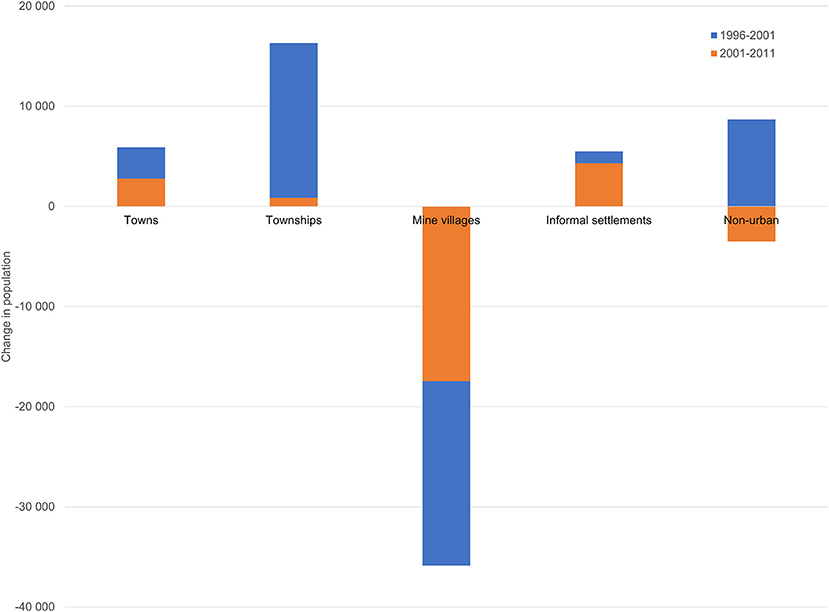
Figure 3. Change in population in Merafong City Local Municipality from 1996 to 2001 and 2001 to 2011 (data sources: StatsSA, 1998, 2003, 2012).
Methodology
Identifying the Communities
This work builds on previous work (Cole and Broadhurst, 2020, 2021) done to understand and measure the SDGs in mining host communities across South Africa. The communities were identified based on a literature review of the history of gold mining in the area (described in Section The West Wits Goldfield), an analysis of the 2011 national census main places and sub places defined by Statistics South Africa (StatsSA) and their key demographics, shown in Table 2, and an exploration of the area in Google maps, shown in Figure 4. The community boundaries were defined by the “main place” boundaries drawn by StatsSA for the 2011 census. Main places are small towns, rural villages, townships and suburbs in large towns and cities. They are often subdivided into “sub places”, which can be specific areas like mines, compounds and nature reserves. The identified communities are summarized in Table 3 where they are categorized as towns, townships, informal settlements, mine villages, industrial areas or rural areas. Seven small towns have the highest percentage of white people (43%), the historically advantaged population, and house 17% of the total population. Six non-white townships are home to almost half the population and almost 12% of the population live in informal settlements. The 22 mine villages are located closest to the mines and are still male dominated (73%) as they accommodate many mine workers in single quarters or hostels. There are two small industrial areas—Nufcor, the site of an old uranium processing plant and its employee village owned by the Nuclear Fuels Corporation of South Africa, and Lenz, a military base—and a few agricultural holdings3, Dennydale, Koksrus, Ten Acre, Zuurbekom and Waterpan. These communities also have higher proportions of men than the towns and townships.
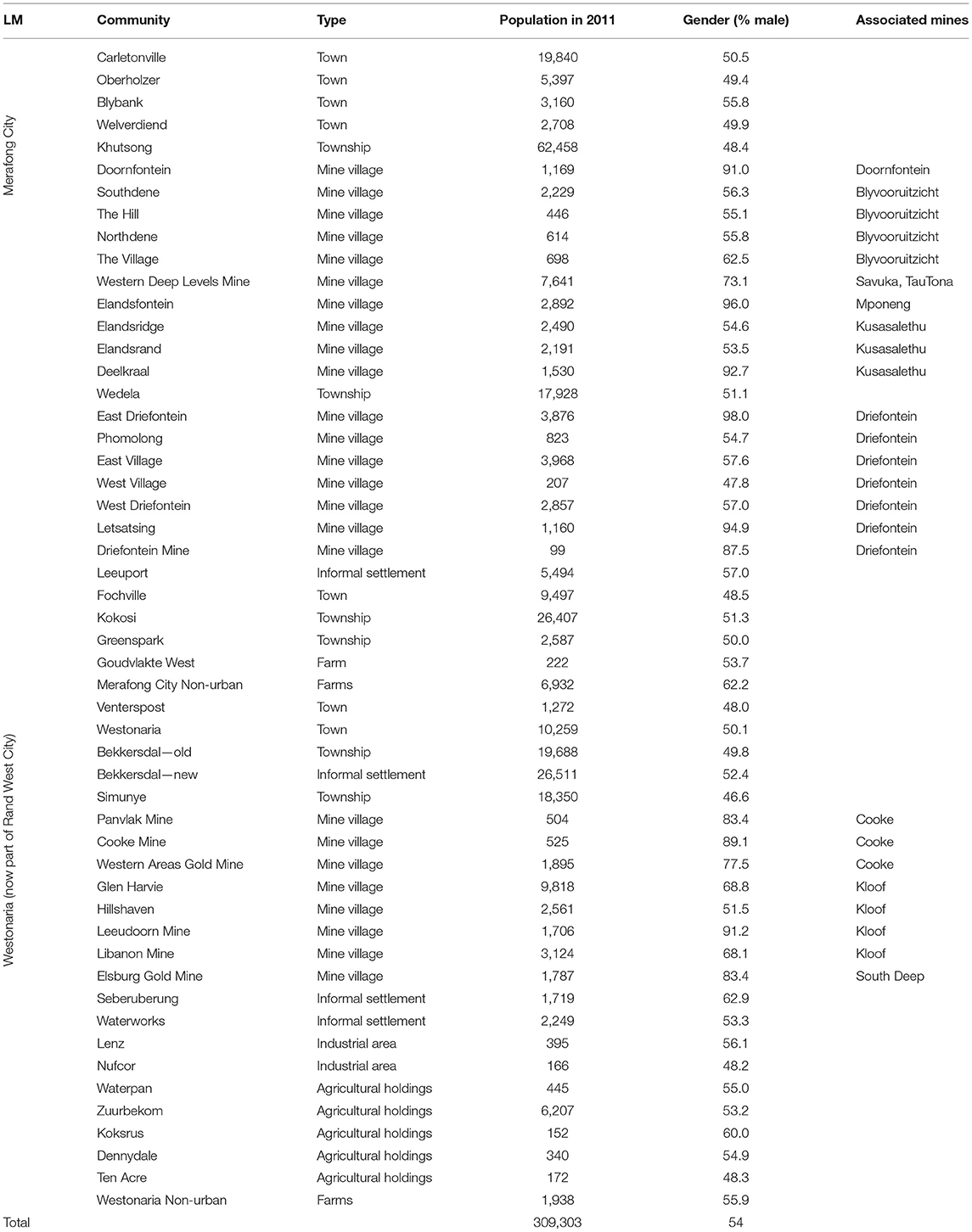
Table 2. Communities in the Far West Rand according to Census 2011 (data source: StatsSA, 2015).
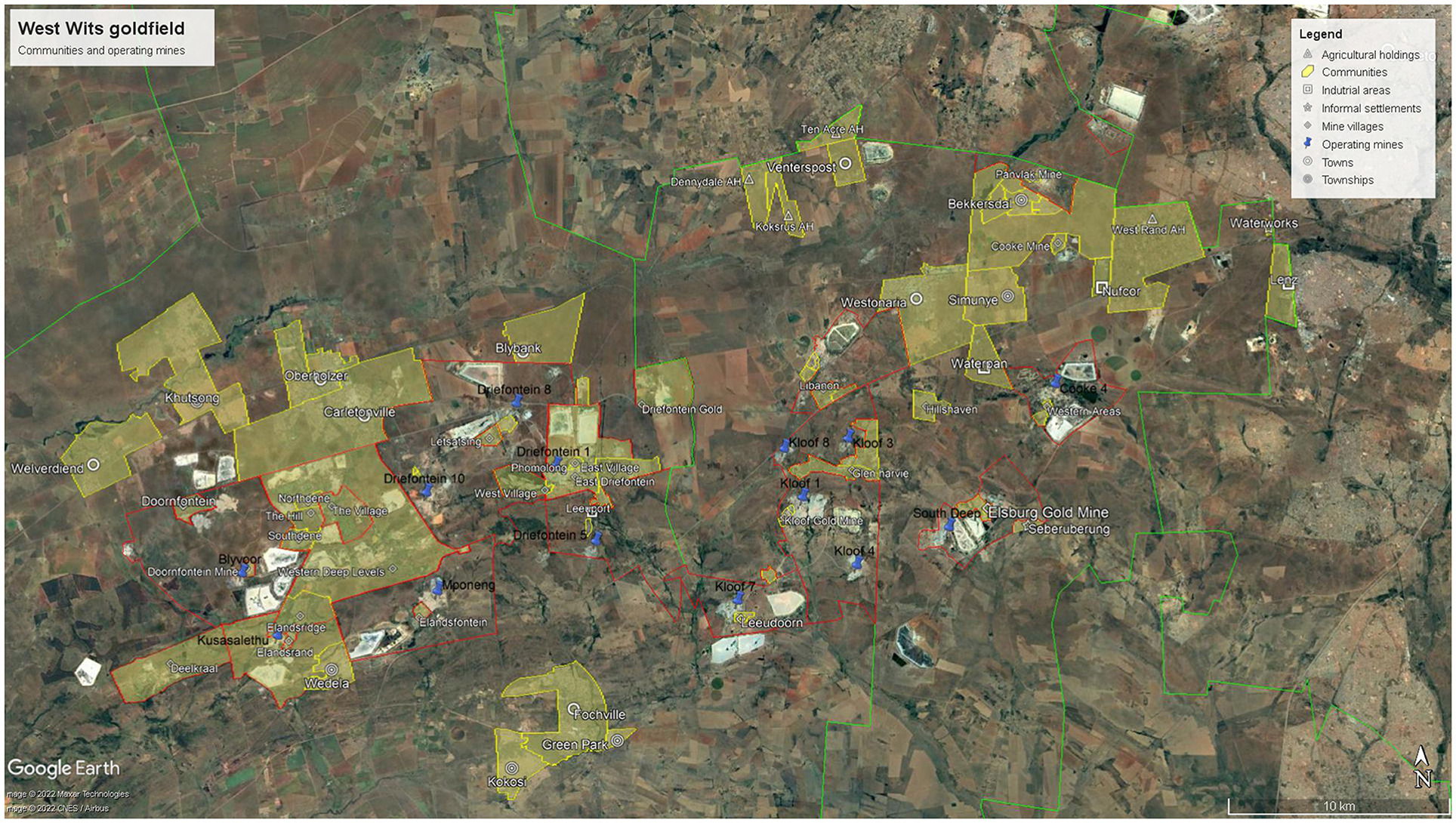
Figure 4. Satellite map of communities (yellow), operating mines (blue pins), mine areas (red borders) and local municipalities (green borders) in the West Wits goldfield (based on Census 2011).
Indicator Selection
All of the current global SDG indicators, the South African SDG baseline report (StatsSA, 2017) and the South African SDG Voluntary National Review Report (StatsSA, 2019a) were reviewed and those that are appropriate for the local level were identified. Twenty-three social, economic and environmental dimensions were identified within 15 SDGs and 20 SDG targets—income (SDG 1), household goods (SDG 1), food security (SDG 2), health (SDG 3), education (SDG 4), gender equality (SDG 5), water access (SDG 6.1), sanitation (SDG 6.2), water quality (SDG 6.3), electricity access (SDG 7.1), clean cooking fuel (SDG 7.1), employment (SDG 8), access to roads (SDG 9), income inequality (SDG 10), housing (SDG 11.1), access to transport (SDG 11.2). waste management (SDG 11.6), air quality (SDG 11.6), hazardous waste (SDG 12.4), climate-related disasters (13), safety (SDG 16) and internet access (SDG 17)—given in Table 4. One indicator was then selected for each dimension based on data availability and the South African Index of Multiple Deprivation, SAIMD (Wright and Noble, 2009). This created a list of 23 suitable local SDG indicators.
Ten of these indicators—including all the environmental ones—could not be measured due to the lack of local level data, despite there being comprehensive data collected by StatsSA and other government agencies for the national and provincial level (e.g., the Victims of Crime Survey, the National Food and Nutrition Security Survey, the National Household Travel Survey). Often environmental indicators are measured for biophysical rather than administrative regions (e.g., freshwater quality), are only reported for selected areas of interest or concern (e.g., air quality), or are only reported at the municipal level (e.g., wastewater treatment). The only indicator selected that is not an official SDG indicator is household goods, which is one of the 11 SAIMD indicators, and a useful proxy for measuring poverty. The SDG 1.2 poverty indicator used in this study is based on (and limited by) the income brackets for annual household income used in the census, rather than the official upper-bound poverty line of R779 per person per month (R9,348 per person per year) for the year 2011 (StatsSA, 2019b), which is not reported at the local level. The health indicator used in this study—per cent of population without a disability—is also not an official SDG indicator but it is meant to be measured as a disaggregation of all social indicators, where possible. It was chosen as local data is not available for the official SDG 3 indicators (e.g., maternal mortality rate, child mortality, HIV prevalence).
Data Collection and Analysis
Main place and sub place data in StatsSA's SuperCross Census 2011 Community Profile Database were obtained from DataFirst at UCT, which provides online access to household survey data in South Africa and Africa (StatsSA, 2015). In total, data were collected for 42 main places and 88 sub places in Merafong City LM and Westonaria LM, for the 13 indicators with available data shown in Table 4. The individual values for all except youth unemployment (as it is a subset of unemployment) were equally weighted and combined into an overall score to facilitate comparison between communities and community types. The data were plotted on radar plots to create “barometers of well-being” that both communicate the results more easily and facilitate comparison between communities. The comparison is as useful or more so than the individual barometers as it gives relative well-being and reduces the influence of the other circumstances on the analysis. These barometers measure progress from the center (zero) toward an acceptable target or social floor, on the outer ring of the plot (100%).
A limitation on the study was that the census does not include data on education, health, employment, income and internet access for collective living quarters and industrial areas because StatsSA uses a different, simpler census questionnaire for institutions (hospitals, prisons, care homes, hostels, boarding schools etc). When aggregating data for main places, StatsSA assigned the institutional population the “not applicable” category despite it being relevant. In the communities in this study, 27,348 people lived in collective living quarters and 3,297 people lived in industrial areas in 2011, together constituting 10% of the total. When calculating percentages in this study, the “not applicable” category was excluded from the total to avoid underestimating the results, unless it was clear that it referred to mine hostels, which were identified by very high household size and percentage of males.
Results
The socio-economic profiles of all the towns, townships, mine villages, informal settlements industrial areas and rural areas in the Far West Rand are given in Table 5 and plotted on barometers of well-being in Figures 5, 6. Full results for individual communities are provided in the Supplementary Tables S2, S3. These overall results show that the towns have the highest levels of well-being, followed by the mine villages, which are probably underestimated because mine hostels are seen as one household and the individuals' data are not included in the census. Also, mine villages are in main places that sometimes include large mine lease areas with informal dwellings, which will lower the levels of well-being. Rural areas and townships have similar well-being and are much better off than the industrial areas and informal settlements. Overall, there is significant variation between different types of communities and large differences between individual indicators, with education and internet access having the lowest levels.
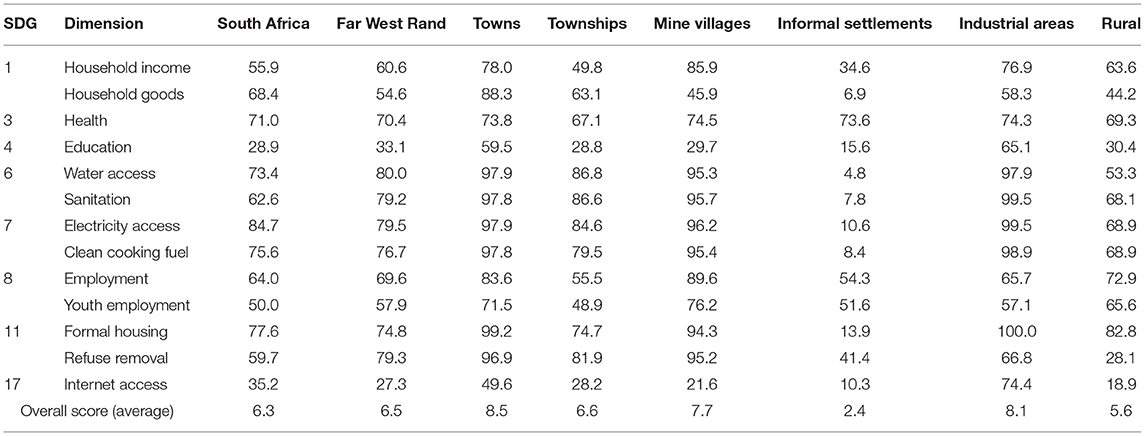
Table 5. Summary of SDG indicators of mining host communities in the Far West Rand (all values except overall score are percentages).
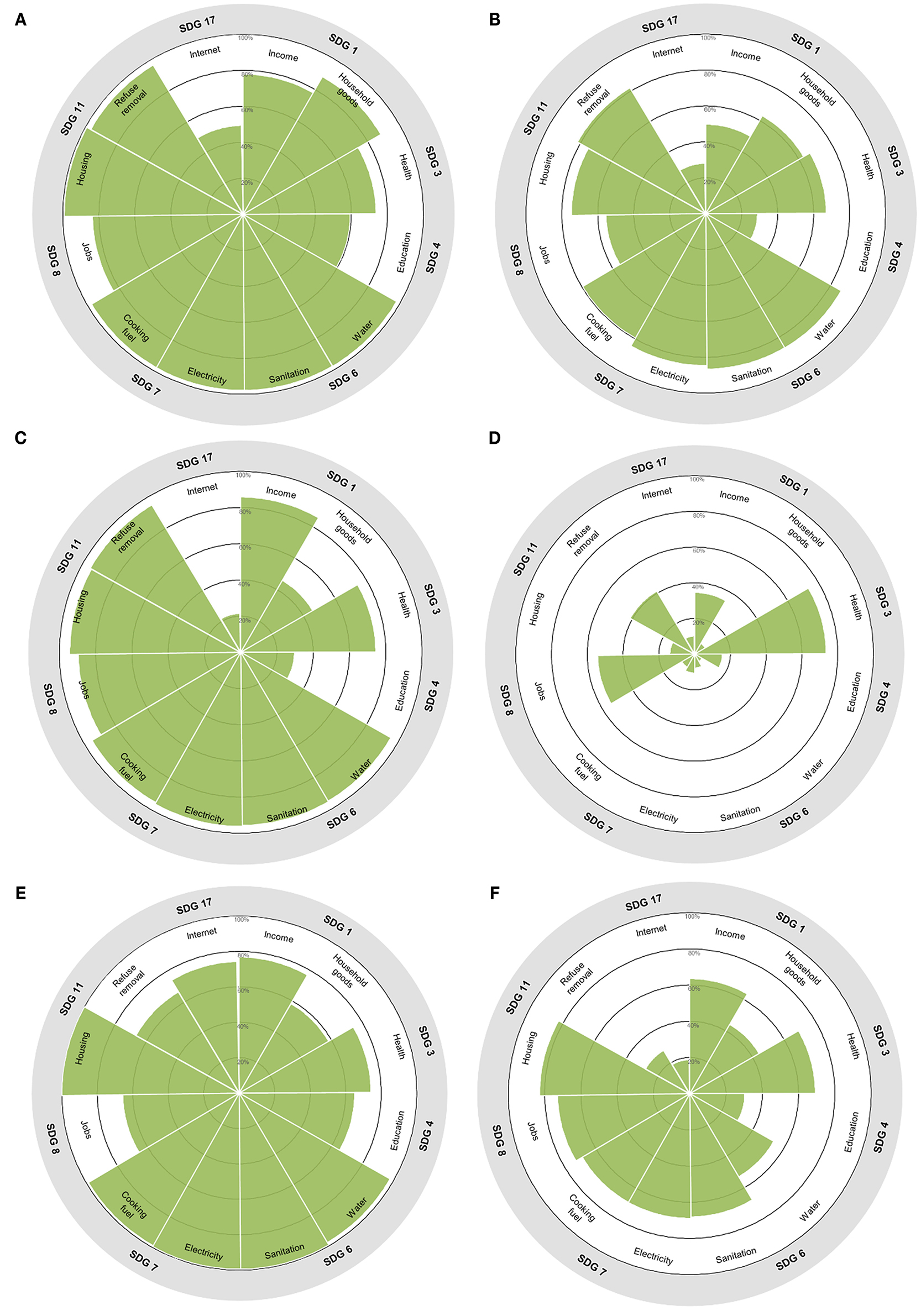
Figure 6. SDG barometers for the Far West Rand (A) towns, (B) townships, (C) mine villages, (D) informal settlements, (E) industrial areas, and (F) rural farming areas.
Basic Services
Overall, the Far West Rand has the highest levels of well-being for basic services—access to piped water, sanitation, electricity and refuse removal—which are all around 80%. The Far West Rand does better than South Africa as a whole on all except electricity access, perhaps because of the high proportion of people living in informal settlements. The levels of basic services varies dramatically across the different types of communities, with all towns and mine villages having above 95% access, and most informal settlements having <5% access (Bekkersdal refuse removal being the exception at over 40%). Townships have fairly high levels of services (between 80 and 90%) while rural areas perform quite badly on basic services, particularly in refuse removal and piped water access.
Livelihoods
About 70% of the labor force in the Far West Rand is employed, 6% more than South Africa as a whole, though only 61% of households are living above the poverty line of R19,600 per year, indicating many people are working in low earning jobs. This may be partly due to the low levels of education—only 33% of adults have completed Grade 12 or a NTC3 qualification, though this is only 4% higher than South Africa as a whole. Employment levels are significantly higher in towns (84%) and mine villages (90%) and lowest in townships (56%) and informal settlements (55%). Youth employment is lower across all communities but lowest in the townships (49%). It is interesting to note that education levels are quite low in the mine villages, which ties in with the low skill levels reported in mining companies SLPs—ranging from 25% of employees at Driefontein to 58% at Kusasalethu. Income levels are very low in informal settlements with 65% of people living below the poverty line of R19,600 per year. Townships are almost as bad, with half the population living below the poverty line.
Living Standards
The impact of the large variation in employment and income levels is seen in living standards across the Far West Rand. Fridge ownership (the indicator for household goods) ranges from 7% in the informal settlements to 89% in the towns. The overall value of 55% for the Far West Rand is 13% lower than the national average, which is counter-intuitive until you consider the high proportion of people living in mine hostels. Health levels do not vary that much across the communities, but this is due to the indicator selected (due to lack of data for other possible health indicators). It is interesting to note that mine villages and industrial areas have the highest proportion of people living with disabilities, although it is only 1% higher than towns and may be a function of different levels of awareness. Clean cooking fuel can be used as a proxy for health as it reduces indoor air pollution (it includes electricity, gas and solar power) and the results show that industrial areas, towns and mine villages have very high levels above 95% while <10% of people in informal settlements use clean cooking fuel. Internet access is low across all types of communities but varies from 50% in towns to 10% in informal settlements.
Discussion
Mining Host Community Well-Being and the SDGs
The results of this study have shown extremely different levels of well-being in different types of communities—with historically advantaged towns and mine villages having much better standards of living than townships, rural areas and particularly informal settlements. This is not unlike the rest of South Africa and is related to the legacy of Apartheid policies of racial segregation and control, poor service delivery by local governments struggling to keep up with growing demand, and the high levels of unemployment in South Africa. Significant and urgent effort is required if these most deprived areas are to have any hope of achieving the SDGs by 2030, particularly in the areas of education (SDG 4), internet access (SDG 17) and employment (SDG 8). This is consistent with other local municipalities that host operating mines in South Africa, and South Africa as a whole (Cole and Broadhurst, 2021).
This case study shows the value of disaggregated data which can be used to identify the most vulnerable members of society and enable tailored social and economic policies to give these groups equal access to opportunities (Maennling and Correa, 2020). Unfortunately, efforts by the national government to address informal settlements in mining areas have not made much progress (Manenzhe, 2018) and the COVID-19 pandemic has hurt the national economy and education outcomes, and exacerbated poverty and inequality as job and income losses hit lower-skilled and uneducated workers the hardest (Ferreira, 2021; World Bank, 2021). Positive signs are evident in renewable energy supply (SDG 7), as all the major mining companies in the West Wits are investing in solar power plants, and in research on fiber-producing crop production that promotes economic diversification (SDG 8) and the bioremediation of the land (SDG 2, SDG 15) (Broadhurst et al., 2019).
One concern regarding the SDGs that has been highlighted in this study is the lack of local level data, particularly for environmental indicators (SDG 6.3, SDG 11.6, SDG 12.4). This is especially concerning in the West Wits where acid mine drainage and dust from tailings facilities pose significant environmental hazards (Broadhurst et al., 2019). Since the SDGs were adopted in 2015, there has been a growing call for localization of the SDGs to expose the multiple inequalities that exist within countries. This is also important for the mining industry, where corporate policies on sustainable development are often not implemented at the mine site level (Responsible Mining Foundation, 2022). While the products of mining are essential for achieving the SDGs at the global and national level, local mine host communities are often negatively impacted by mining (Lèbre et al., 2020; Luckeneder et al., 2021). It is essential that adequate reporting and monitoring is conducted. Ideally, this would be a partnership between the mining companies, local and national government and civil society, as envisaged in SDG 17.
Defining the Mining Host Community
An important aspect of measuring the SDGs in mining communities is defining and delineating these communities. This study and a previous study (Cole and Broadhurst, 2020) has shown that South Africa has very different types of communities, and begs the questions, what is a mining host community? There has been no clear definition of mining communities globally, although underlying the international legal definitions is the idea of shared poverty, inequality and legacy of past exploitation (Heyns, 2019). In Australia and Canada there has been a major shift in the nature of mine communities, with many mine workers living far from the mine site, often in regional towns or cities, and commuting on a weekly basis (Storey, 2016; Marais et al., 2018a). This complicates the definition of community and makes it difficult to measure its well-being. In South Africa, there have been several different definitions used in the regulations. The MPRDA (Republic of South Africa, 2002) focused on historically disadvantaged persons with interest or rights in a particular area of land directly affected by mining while the 2010 Mining Charter added labor-sending areas to the definition (Government of South Africa, 2010) and the 2018 Mining Charter defined a host community as a community within a local or metropolitan municipality adjacent to the mining area (Government of South Africa, 2018). The labor-sending areas are important as remittances sent home by mine workers reduces poverty in rural areas (IRR, 2014)—for example Harmony estimate that half of monthly salaries are sent home (Harmony, 2018). In South Africa, mining companies generally base their Local Economic Development projects in their SLPs on communities chosen by the local municipalities, which is vulnerable to bias and exclusion and can lead to conflict between mining companies and communities. This is even more complicated considering tens of thousands migrant workers come from neighboring states.
Some mining companies refer to a “zone of influence” that includes the communities adjacent to the mine, those further out (perhaps 50 km away) and the municipality or region they are located in. While this is a helpful differentiation, it does not remove the expectations from community members that the mining company is going to directly improve their lives. Some organizations have suggested that mining taxes should be directed into these areas, however, this would significantly reduce the amount available to the national fiscus for more general expenditure (IRR, 2014). There is the risk that there is large-scale out-migration from mining towns post-closure, and therefore only spending in these towns does not make sense at the national level (IRR, 2014). This case study has highlighted that each mine and mine community is unique—with a different history, cultural context, labor force, company footprint and resources—and solutions need to be negotiated to suit all stakeholders.
Mine Closure and the SDGs
Mine closure is a growing concern in South Africa and globally, with its potential negative impacts on water resources (SDG 6), land degradation (SDG 14), air quality (SDG 11), jobs and markets for local businesses (SDG 8). The actual reasons why mines close are diverse and include economic, geological, geotechnical, regulatory, community and other pressures (Laurence, 2006). While environmental issues are usually at the forefront of mine closure planning, social and economic impacts in mining-dependent communities are significant and alternative sources of employment and income need to be considered (Holcombe and Keenan, 2020). The lack of alternative economic opportunities in the West Wits and the general low levels of education (SDG 4), internet access (SDG 17) and employment (SDG 8) indicate a high social vulnerability to mine closure. The Far West Rand has experienced some of the impacts of mine closure, most notably with the sudden closure of Blyvooruitzicht mine in 2013 as a result of financial difficulties. Neither mining company on either side of a sale transaction took responsibility for the mine and this led to sudden job losses, electricity being cut off to the mine and mine village, rubbish collection halting, the sewage system breaking down for lack of maintenance, the shaft flooding (increasing the risk of acid mine drainage), and dust suppression measures at the tailings storage facilities ceasing, all resulting in significant health and safety risks to the mine village residents and environmental damage (Lawyers for Human Rights, 2017). Thus mine closure threatens the achievement of numerous SDGs (1, 2, 3, 6, 7, 8, 11, 12, 14, 15).
Despite the short life of mine of many of the operating shafts in the West Wits, this does not necessarily mean that they will close on this date, as this is based on the current mineral reserve. They all have bigger mineral resources which could be converted to reserves if the conditions are right (Harmony, 2021; Sibanye-Stillwater, 2022). The main limitation in the West Wits is the depth of the orebody—the shallow ore has been removed and mines are already the deepest in the world. Minerals Council South Africa (2018) has estimated that mechanization and modernization could extend the life of conventional mines in the West Wits goldfields by 15 years. This has already been proved to some degree by South Deep mine, which has extended its life of mine to 2106 by converting to high profile mechanized mining, and the new Blyvoor Gold mine which has a life of mine of 50 years. With the high gold price (currently ~ USD1,900, about six times what it was 20 years ago), old mines are reopening, such as the Witwatersrand Basin Project in the Central Rand (West Wits Mining, 2022), and mining companies like DRDGold are extracting gold from tailings storage facilities and waste dumps. These recent developments mean that the West Wits can continue to be a mining area for many years and has the opportunity to minimize the adverse impacts of mine closure on the communities. However, this study has shown that business as usual cannot continue if they hope to meet the SDGs in all communities. Mining companies, local governments and national government must work together to make substantial progress toward the SDGs and ensure no-one is left behind.
Conclusion
The aim of this study was to identify all the host communities in the West Wits goldfield in South Africa and measure a comprehensive set of relevant SDG indicators, to explore the local variations in well-being that are hidden at national and municipal level, and the implications for communities achieving the SDGs in the context of mine closure. It has highlighted the extreme inequalities that exist between neighboring communities and their very different chances of achieving the SDGs by 2030. It has discussed the challenges around lack of local level data, defining who the mining host communities are, and the risks and opportunities related to mine closure. This paper thus provides an in-depth case study into some of the most difficult and contentious debates facing the mining industry today. It is clear that sustainable development in mining host communities relies on collaboration between multiple mining companies, local government authorities, civil society and the communities themselves.
Data Availability Statement
The original contributions presented in the study are included in the article/Supplementary Material, further inquiries can be directed to the corresponding author/s.
Author Contributions
MC conceived and designed the work, collected the data, performed the analysis, and wrote the paper. JB conceived the work. Both authors contributed to the article and approved the submitted version.
Funding
This work was funded by the University of Cape Town and Harmony Gold.
Conflict of Interest
The authors declare that the research was conducted in the absence of any commercial or financial relationships that could be construed as a potential conflict of interest.
Publisher's Note
All claims expressed in this article are solely those of the authors and do not necessarily represent those of their affiliated organizations, or those of the publisher, the editors and the reviewers. Any product that may be evaluated in this article, or claim that may be made by its manufacturer, is not guaranteed or endorsed by the publisher.
Acknowledgments
The authors appreciate the input of the two reviewers.
Supplementary Material
The Supplementary Material for this article can be found online at: https://www.frontiersin.org/articles/10.3389/frsc.2022.895760/full#supplementary-material
Footnotes
1. ^Unlike company towns which are only for mining employees, open towns have no restrictions.
2. ^Townships are residential areas in South Africa typically designed as labor dormitories for black workers during Apartheid, with “matchbox houses” and grid-like dusty streets (Bezuidenhout and Buhlungu, 2010).
3. ^A portion of land not less than 1 morgen (8,565 m2) used for agricultural purposes.
References
AngloGold Ashanti (2019). AngloGold Ashanti South Africa West Wits Operations Social and Labour Plan 2020–2024. Johannesburg: AngloGold Ashanti.
Bainton, N., Kemp, D., Lèbre, E., Owen, J. R., and Marston, G. (2021). The energy-extractives nexus and the just transition'. Sustain. Develop. 29, 624–634. doi: 10.1002/sd.2163
Bezuidenhout, A., and Buhlungu, S. (2010). From compounded to fragmented labour: Mineworkers and the demise of compounds in South Africa. Antipode. 43, 237–263. doi: 10.1111/j.1467-8330.2010.00758.x
Blyvoor Gold (2022). History of the Blyvoor Mine. Available online at: https://www.blyvoorgold.com/wp-content/uploads/2019/04/History-of-the-Blyvoor-Mine.pdf (accessed November 6, 2020).
Brink, B., and Pienaar, J. (2007). Business and HIV/AIDS: The case of Anglo American. Aids. 21, 79–84. doi: 10.1097/01.aids.0000279697.40568.fd
Broadhurst, J., Amaral Filho, J., Moyo, A., Nwaila, P. Sampa N'gandu, H., et al. (2019) Resource Efficient Socially Responsible Approaches for the Integrated Management of Mine Waste: Understanding the Risks, Opportunities, Enablers and Barriers. South African Water Research Commission Report No. 2580/1/19 (ISBN 978-0-6392-0077-4), September 2019.
Broadhurst, J. L. (2019). “The contribution of mining to clean water and sanitation (SDG 6): case studies from South Africa,” in Sustainable Development in Africa: Case Studies. M. Nagao, J. Masinja, and A. Alhassan (eds). (Colorado: Spears Media Press), 1–16.
Bundy, C. J., and Cobbing, J. R. D. (2019). “Diamonds, gold and imperialist intervention (1870-1902),” in South Africa—History. Encyclopaedia Britannica inc. Available online at: https://www.britannica.com/place/South-Africa/History (accessed May 27, 2020).
CCSI, SDSN, UNDP, and WEF (2016) Mapping Mining to the Sustainable Development Goals: An Atlas. Columbia Center on Sustainable Investment (CCSI).
Cloete, J., and Marais, L. (2021). Mine housing in the South African coalfields: the unforeseen consequences of post-apartheid policy. Hous. Stud. 36, 1388–1406. doi: 10.1080/02673037.2020.1769038
Cole, M. J., Bailey, R. M., Cullis, J. D. S., and New, M. G. (2018). Spatial inequality in water access and water use in South Africa. Water Policy. 20, 37–52. doi: 10.2166/wp.2017.111
Cole, M. J., Bailey, R. M., and New, M. G. (2017). Spatial variability in sustainable development trajectories in South Africa: provincial level safe and just operating spaces. Sustainability Science. 12, 829–848. doi: 10.1007/s11625-016-0418-9
Cole, M. J., and Broadhurst, J. L. (2020). Mapping and classification of mining host communities: a case study of South Africa. Extract. Indus. Soc. 7, 954–964. doi: 10.1016/j.exis.2020.06.007
Cole, M. J., and Broadhurst, J. L. (2021). Measuring the sustainable development goals (SDGs) in mining host communities: A South African case study. Extract. Indus. Soc. 8, 233–243. doi: 10.1016/j.exis.2020.11.012
DMR (2010). Guideline for the Submission of a Social and Labour Plan As Required in Terms of Regulation 46 of the Mineral and Pertoleum Resources Development Act (Act 28 of 2002). Pretoria: Department of Mineral Resources, Government of South Africa. Available online at: http://www.dmr.gov.za/Portals/0/social%20and%20labour%20plan_guideline.pdf (accessed May 19, 2020).
DMR (2018). Broad-based Socio-economic Empowerment Charter for the Mining and Minerals Industry, 2018, Government Gazette. South Africa.
DMR (2019). Housing and Living Conditions Standard for the Minerals Industry, 2019. Department of Mineral Resources, Government Gazette No. 42899. Republic of South Africa (accessed December 11, 2019).
Elshkaki, A., Graedel, T. E., Ciacci, L., and Reck, B. K. (2016). Copper demand, supply, and associated energy use to 2050. Glob. Environ. Chang. 39, 305–315. doi: 10.1016/j.gloenvcha.2016.06.006
Elshkaki, A., Graedel, T. E., Ciacci, L., and Reck, B. K. (2018). Resource Demand Scenarios for the Major Metals. Environ. Sci. Technol. 52, 2491–2497. doi: 10.1021/acs.est.7b05154
Ferreira (2021). Inequality in the Time of COVID-19. Available online at: https://www.imf.org/external/pubs/ft/fandd/2021/06/inequality-and-covid-19-ferreira.htm (accessed 4 May 2022)
Fraser, J. (2019). Creating shared value as a business strategy for mining to advance the United Nations Sustainable Development Goals. Extr. Ind. Soc. 6, 788–791. doi: 10.1016/j.exis.2019.05.011
Gold Fields (2009a). Driefontein Technical Short Form Report. Johannesburg: Gold Fields. Available online at: https://www.goldfields.come/reports/rr_2009/tech_drie.php (accessed January 28, 2021).
Gold Fields (2009b). Kloof Technical Short Form Report. Johannesburg: Gold Fields. Available online at: https://www.goldfields.come/reports/rr_2009/kloof.php (accessed January 28, 2021).
Gold Fields (2017). South Deep Gold Mine Social and Labour Plan 2018-2022. Johannesburg: Gold Fields. Available online at: https://www.goldfields-southdeep.co.za/downloads/send/23-documents/84-south-deep-social-and-labour-plan-2018-2022 (accessed January 28, 2021).
Gold Fields (2021). Mineral Resources and Mineral Reserves Supplement to the Integrated Annual Report 2021. Johannesburg: Gold Fields. Available online at: https://www.goldfields.com/pdf/investors/integrated-annual-reports/2021/mrmr-2021.pdf (accessed January 27, 2022).
Government of South Africa (2010). Broad-Based Socio-economic Empowerment Charter for the Mining and Minerals Industry, 2010. Government Gazette, No. 33573 (accessed September 20, 2010).
Government of South Africa (2018). Broad-based Socio-economic Empowerment Charter for the Mining and Minerals Industry, 2018. Government Gazette, No. 41934 (accessed September 27, 2018).
Hamann, R. (2004). Corporate social responsibility, partnerships, and institutional change: The case of mining companies in South Africa. Nat. Resour. Forum. 28, 278–290. doi: 10.1111/j.1477-8947.2004.00101.x
Harmony (2018). Social and Labour Plan 2018 to 2022 Kusasalethu Operation. Johannesburg: Harmony. Available online at: https://www.harmony.co.za/component/jdownloads/send/133-slps/3570-kusasalethu-2018-2022-english (accessed September 22, 2020).
Harmony (2021). Mineral Resources and Minerals Reserves Report 2021. Johannesburg: Harmony Gold Mining Company. Available online at: https://www.har.co.za/21/download/HAR-RR21.pdf (accessed January 21, 2022).
Heyns, A. (2019). Mining community development in South Africa: A critical consideration of how the law and development approach the concept “community”. Law Develop. Rev. 12, 561–593. doi: 10.1515/ldr-2019-0022
Holcombe, S., and Keenan, J. (2020). Mining as a Temporary Land Use Scoping Project: Transitions and Repurposing. Brisbane: Centre for Social Responsibility in Mining, University of Queensland.
ICMM (2018). Making a Positive Contribution to the SDGs. Available online at: https://www.icmm.com/en-gb/mining-metals/making-a-positive-contribution
IRR (2014). Digging for development: The mining industry in South Africa and its role in socio-economic development. F. Cronje, J. Kane-Berman, and L. Moloi (eds.). Johannesburg: South African Institute of Race Relations (IRR).
Kumi, E., Yeboah, T., and Kumi, Y. A. (2020). Private sector participation in advancing the Sustainable Development Goals (SDGs) in Ghana: experiences from the mining and telecommunications sectors. Extr Ind Soc. 7, 181–190. doi: 10.1016/j.exis.2019.12.008
Laurence, D. (2006). Optimisation of the mine closure process. J. Clean. Prod. 14, 285–298. doi: 10.1016/j.jclepro.2004.04.011
Lawyers for Human Rights (2017). Blyvooruitzicht Mine Village: The Human Toll of State and Corporate Abdication of Responsibility in South Africa. Pretoria: FIDH.
Lèbre, É., Stringer, M., Svobodova, K., Owen, J. R., Kemp, D., Côte, C., et al. (2020). The social and environmental complexities of extracting energy transition metals. Nat. Commun. 11, 1–8. doi: 10.1038/s41467-020-18661-9
Liefferink, S. L., van Eeden, E. S., and Wepener, V. (2017). Past, present and future use of municipal water and freshwater resources of the Bekkersdal community, Westonaria, South Africa. J. Sustain. Develop. Energy Water Environ. Syst. 5, 430–446. doi: 10.13044/j.sdewes.d5.0155
Luckeneder, S., Giljum, S., Schaffartzik, A., Maus, V., and Tost, M. (2021). Surge in global metal mining threatens vulnerable ecosystems. Global Environ. Change. 69, 102303. doi: 10.1016/j.gloenvcha.2021.102303
Maennling, A. N., Toledano, P., and Sachs, L. (2019). Using the SDG Framework to Advance Local Development Where Vale Operates: A Case Study from Canaa dos Carajas. New York: Columbia Center on Sustainable Investment (CCSI).
Maennling, N., and Correa, J. (2020). Best Practices in Data Driven Development Planning in Mining Regions. New York: Columbia Center on Sustainable Investment (CCSI).
Mancini, L., and Sala, S. (2018). Social impact assessment in the mining sector: Review and comparison of indicators frameworks. Resour. Policy. 57, 98–111. doi: 10.1016/j.resourpol.2018.02.002
Manenzhe, T. D. (2018). A Critical Review of the Housing Policy and the State's Intervention in Mining Towns in South Africa. University of Cape Town.
Marais, L., Cloete, J., and Denoon-Stevens, S. (2018b). Informal settlements and mine development: Reflections from South Africa's periphery. J. South. Afr. Inst. Min. Metallur. 118, 1103–1111. doi: 10.17159/2411-9717/2018/v118n10a12
Marais, L., McKenzie, F. H., Deacon, L., Nel, E., van Rooyen, D., and Cloete, J. (2018a) “The changing nature of mining towns: Reflections from Australia, Canada South Africa. Land Use Policy. 76, 779–788. doi: 10.1016/j.landusepol.2018.03.006
Minerals Council South Africa (2018). People-Centred Modernisation in Mining—Position Paper. Johannesburg: Minerals Council South Africa. Available online at: http://www.mineralscouncil.org.za/industry-news/publications/position-papers/send/37-position-papers/593-people-centred-modernisation-in-mining (accessed January 20, 2022).
Moomen, A.-W., Bertolotto, M., Lacroix, P., and Jensen, D. (2019). Inadequate adaptation of geospatial information for sustainable mining towards agenda 2030 sustainable development goals. J. Clean. Product. 238, 117954. doi: 10.1016/j.clepro.2019.119754
Rand West City Local Municipality (2016). Draft Integrated Development Plan 2016/7−2020/21. Rand West City Local Municipality.
Republic of South Africa (2002). Act No. 28 of 2002: Mineral and Petroleum Resources Development Act, 2002. Government Gazette, Vol 448, Cape Town.
Responsible Mining Foundation (2020). Responsible Mining Index Report 2020: Summary. Switzerland: Responsible Mining Foundation (RMF).
Responsible Mining Foundation (2022). Responsible Mining Index Report 2022. Switzerland: Responsible Mining Foundation (RMF).
Sibanye-Stillwater (2017a). Driefontein Operation Social and Labour Plan 2017-−2021. Johannesburg: Sibanye-Stillwater.
Sibanye-Stillwater (2017b). Kloof Operation 2017-2021 Social and Labour Plan. Johannesburg: Sibanye-Stillwater.
Sibanye-Stillwater (2022). 2021 Mineral Resources and Mineral Reserves Report. Johannesburg: Sibanye-Stillwater. Available online at: reports.sibanyestillwater.com/2021/download/SSW-RR21.pdf
StatsSA (1998). ‘South African Census Community Profiles 1996 Dataset’. Pretoria: Statistics South Africa.
StatsSA (2003). South African Census Community Profiles 2001 Dataset. Pretoria: Statistics South Africa.
StatsSA (2015). South African Census Community Profiles 2011 dataset Version 1. Pretoria: Statistics South Africa.
StatsSA (2016a). Community Survey 2016 Statistical release P0301. Pretoria: Statistics South Africa.
StatsSA (2017). Sustainable Development Goals Indicator Baseline Report 2017—South Africa. Pretoria: Statistics South Africa.
StatsSA (2019a). Sustainable Development Goals (SDGs) Country Report 2019—South Africa. Pretoria: Statistics South Africa.
StatsSA (2019b). National Poverty Lines 2019 Statistical release P0310, 1. Pretoria: Statistics South Africa.
Storey, K. (2016). The evolution of commute work in the resource sectors in Canada and Australia. Extract. Indus. Soc. 3, 584–593. doi: 10.1016/j.exis.2016.02.009
Sturman, K., Rogers, P., Imbrogiano, J., Mori Junior, R., and Ezeigbo, C. (2018). Monitoring impact of mineral sustainability standards to align with the Sustainable Development Goals. Brisbane. Available online at: http://www.csrm.uq.edu.au (accessed July 4, 2020).
Tucker, R. F., Viljoen, R. P., and Viljoen, M. J. (2016). A review of the Witwatersrand basin—the world's greatest goldfield. Episodes. 39, 105–133. doi: 10.18814/epiiugs/2016/v39i2/95771
UN General Assembly (2015). Transforming Our World: The 2030 Agenda for Sustainable Development. New York: United Nations General Assembly.
UN Statistical Commission (2020). Global indicator framework for the Sustainable Development Goals and targets of the 2030 Agenda for Sustainable Development, Work of the Statistical Commission pertaining to the 2030 Agenda for Sustainable Development. Available online at: https://unstats.un.org/sdgs/indicators/GlobalIndicatorFramework_A.RES.71,313.Annex.pdf (accessed July 7, 2020).
Van Eeden, E., de Villiers, B., Strydom, H., and Stoch, L. (2003). Effects of dewatering and sinkholes on people and environment—an analysis of the Carletonville area in Gauteng, South Africa. Historia. 48, 95–125. doi: 10.10520/EJC38107
van Eeden, E. (1997). So long, gold mines long live industries? A case study of Carletonville's battle for economic survival. S. Afr. J. Econ. Hist. 12, 103–127. doi: 10.1080/10113439709511097
Vidal, O., Goffe, B., and Arndt, N. (2013). Metals for a low-carbon society. Nat Geosci. 6, 894–896. doi: 10.1038/ngeo1993
Watari, T., Nansai, K., and Nakajima, K. (2020). Review of critical metal dynamics to 2050 for 48 elements. Resour. Conserv. Recycl. 155, 104669. doi: 10.1016/j.resconrec.2019.104669
West Wits Mining (2022). Witwatersrand Basin Project. Available online at: https://westwitsmining.com/witwatersrand-basin-project/?target=project-overview (accessed February 28, 2022).
Winde, F., and Stoch, E. J. (2010). Threats and opportunities for post-closure development in dolomitic gold-mining areas of the West Rand and Far West Rand (South Africa)—A hydraulic view Part 1: Mining legacy and future threats. Water SA. 36, 75–82. doi: 10.4314/wsa.v36i1.50909
World Bank (2021). South Africa Overview. Available online at: https://www.worldbank.org/en/country/southafrica/overview#1 (accessed May 4, 2022). doi: 10.1596/36514
World Gold Council (2020). Gold Mining's Contribution to the UN Sustainable Development Goals. London: World Gold Council.
Wright, G., and Noble, M. (2009). The South African Index of Multiple Deprivation 2007 at Municipality Level. Pretoria: Department of Social Development, Government of South Africa.
Yager, T. R. (2021). 2016 Minerals Yearbook The Mineral Industry of the South Africa. United States Geological Survey.
Keywords: Sustainable Development Goals, indicators, South Africa, mine closure, SDG localization, mining communities, community well-being
Citation: Cole MJ and Broadhurst JL (2022) Sustainable Development in Mining Communities: The Case of South Africa's West Wits Goldfield. Front. Sustain. Cities 4:895760. doi: 10.3389/frsc.2022.895760
Received: 14 March 2022; Accepted: 23 May 2022;
Published: 30 June 2022.
Edited by:
Godwin Arku, Western University, CanadaReviewed by:
Deidre Van Rooyen, University of the Free State, South AfricaLochner Marais, University of the Free State, South Africa
Copyright © 2022 Cole and Broadhurst. This is an open-access article distributed under the terms of the Creative Commons Attribution License (CC BY). The use, distribution or reproduction in other forums is permitted, provided the original author(s) and the copyright owner(s) are credited and that the original publication in this journal is cited, in accordance with accepted academic practice. No use, distribution or reproduction is permitted which does not comply with these terms.
*Correspondence: Megan J. Cole, bWVnYW4uY29sZUB1Y3QuYWMuemE=
 Megan J. Cole
Megan J. Cole Jennifer L. Broadhurst
Jennifer L. Broadhurst